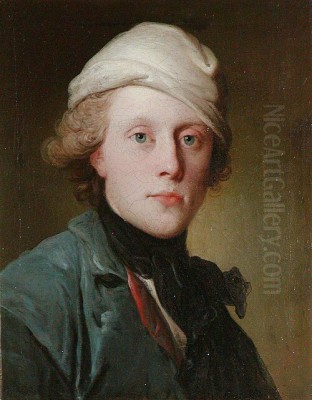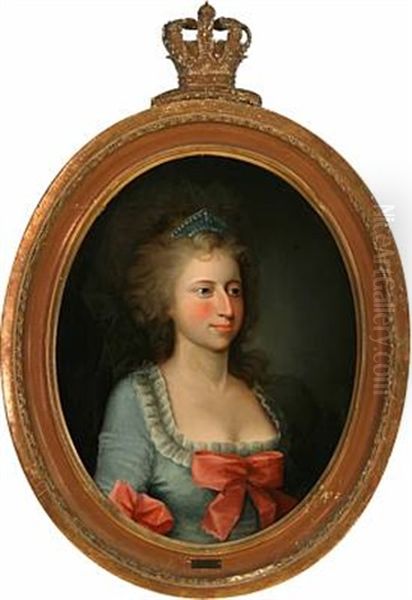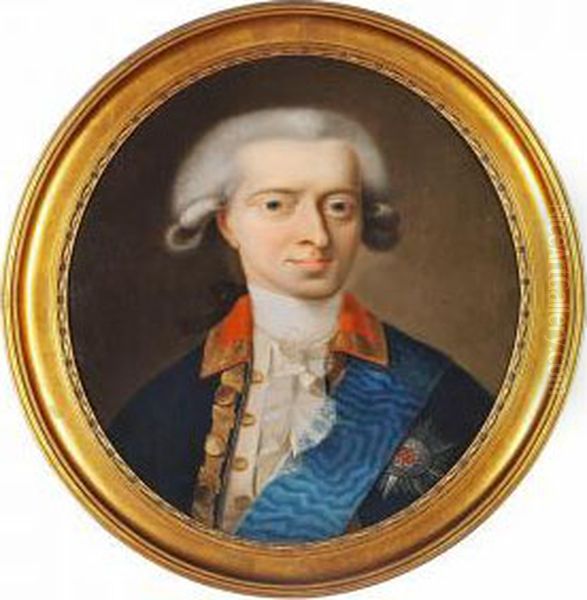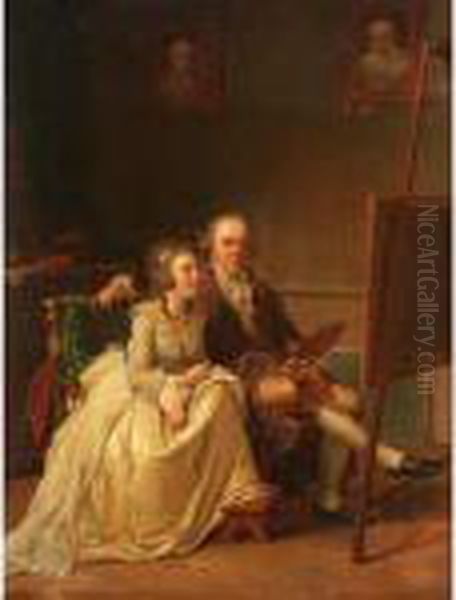
Jens Juel (1745-1802) stands as one of the most significant figures in Danish art history, renowned primarily for his mastery of portraiture during the latter half of the 18th century. His prolific output and distinct style captured the essence of the Danish elite – royalty, nobility, and the affluent bourgeoisie – making him a central figure in the cultural landscape of his time. His work not only reflects the artistic trends shifting from Rococo towards Neoclassicism and early Romanticism but also provides an invaluable visual record of Danish society during a period of transformation.
Early Life and Artistic Formation
Born in 1745 on the island of Funen, Denmark, Jens Juel displayed an early inclination towards the arts. While Denmark's educational system at the time provided theoretical grounding, practical painting instruction within the academic framework was limited. Consequently, the young Juel sought hands-on training abroad. He journeyed to Hamburg, Germany, where he apprenticed under the painter Johann Michael Gehrmann. This period was crucial for developing his foundational skills.
Upon completing his apprenticeship, Juel's talent quickly matured. Around 1765, he returned to Copenhagen and enrolled in the newly established Royal Danish Academy of Fine Arts. This institution, modeled after the prestigious French Académie Royale de Peinture et de Sculpture, provided a more structured environment. Here, Juel absorbed the prevailing artistic theories and likely encountered the influence of prominent figures associated with the Academy, such as the Swedish-born court painter Carl Gustaf Pilo and potentially the sculptor Johannes Wiedewelt, though the provided text specifically mentions Pilo and a figure named "Thorck" as influences during his Academy time.
The Grand Tour and International Exposure
Like many ambitious artists of his era, Juel embarked on a Grand Tour to broaden his artistic horizons and absorb the influences of continental Europe's major art centers. Around 1772, he began an extended period of travel and study that took him to Rome, Paris, and Geneva. This journey proved transformative, exposing him to classical antiquity, the masterpieces of the Italian Renaissance and Baroque periods, and the contemporary art scenes of Italy and France.

In Rome, the epicenter of Neoclassicism, Juel undoubtedly studied ancient sculptures and the works of Renaissance masters. It was also a hub for international artists. During this period, he formed a significant connection with his compatriot, the historical painter Nicolai Abildgaard. Their time together in Rome fostered a lasting friendship, which continued upon their return to Denmark, with Abildgaard later painting a portrait of Juel. Exposure to artists like Anton Raphael Mengs, a leading proponent of Neoclassicism then active in Rome, would also have been likely.
His time in Paris exposed him to the sophisticated French portrait tradition and the lingering elegance of the Rococo style, even as Neoclassicism, championed by artists like Jacques-Louis David, was gaining momentum. In Geneva, Switzerland, Juel encountered a different atmosphere and landscape, which notably influenced his burgeoning interest in landscape painting. This period abroad was instrumental in refining his technique, expanding his stylistic repertoire, and establishing his reputation on an international level.
Rise to Prominence in Denmark
Upon returning to Denmark around 1780, Juel found a receptive audience for his refined and elegant style. His European experiences had polished his skills and lent him an international cachet. He quickly established himself as the leading portrait painter in Copenhagen, sought after by the highest echelons of society. His ability to capture not only a likeness but also the status and character of his sitters made him exceptionally popular.
His success led to prestigious appointments. He became the official court portrait painter, entrusted with depicting the Danish royal family. His works from this period include portraits of King Christian VII and other members of the royal household, solidifying his position at the pinnacle of the Danish art world. His painting The Crowned Robes of the Monarch, depicting the ceremonial attire of King Christian VII, exemplifies his connection to the crown.
Beyond the court, Juel cultivated relationships with the nobility and the increasingly wealthy merchant class. The rise of this bourgeoisie created a new market for portraiture, and Juel adeptly navigated this social landscape. His success was built not only on artistic talent but also on astute social networking and perhaps a degree of self-promotion, allowing him to secure a steady stream of commissions and become a prominent public figure.
Artistic Style: Elegance Meets Naturalism
Jens Juel's artistic style is characterized by a sophisticated blend of elegance, sensitivity, and a commitment to naturalistic representation. While his early works show traces of the decorative Rococo style prevalent during his formative years, he increasingly moved towards a more restrained and natural manner, influenced by Neoclassical ideals of clarity and order, yet infused with a unique warmth and psychological insight.

His portraits are celebrated for their graceful compositions and delicate brushwork. He possessed a remarkable ability to flatter his subjects, presenting them in their best light, while simultaneously retaining a convincing sense of realism. Unlike the sometimes dramatic or overtly emotional tendencies seen in French Romanticism, Juel's approach was generally more composed and serene, focusing on capturing the individual's personality through subtle expression and posture. His style was often described by contemporaries as "natural, pleasant, and profound."
A key element of his style was the harmonious integration of the figure with the background. Whether placing a subject against a simple, atmospheric backdrop or within a detailed interior or landscape setting, Juel ensured that the environment complemented and enhanced the portrayal of the individual. This careful balance contributes significantly to the overall elegance and coherence of his works. He particularly excelled in rendering textures – the sheen of silk, the softness of velvet, the glint of jewelry – adding to the tactile quality and realism of his paintings.
Masterpieces and Signature Works
Jens Juel's extensive oeuvre includes numerous works that are considered highlights of Danish art. Among his most celebrated portraits is that of The Young Prince Noer, also identified more formally as Prince Christian of Schleswig-Holstein-Sønderborg-Augustenburg. This work, likely depicting the prince in his youth, showcases Juel's skill in capturing youthful innocence combined with aristocratic bearing, rendered with exquisite detail and sensitivity.
His talent for depicting children is further evident in works like The Running Boy. This painting is noted for its dynamic portrayal of movement and its masterful use of light and shadow to create a sense of volume and life. Juel's Children's Portraits as a group are considered milestones in Danish art history, praised for their unprecedented naturalism and empathy, moving away from stiff, formal representations towards more intimate and lively depictions.
Juel also painted group portraits, such as Niels Rebech and his Son Christian and his Daughter-in-law Engelsk, demonstrating his ability to handle complex compositions involving multiple figures and their interrelationships. His connection to the monarchy is highlighted in The Crowned Robes of the Monarch, focusing on the regalia of King Christian VII.

Beyond portraiture, Juel made significant contributions to landscape painting. His travels, particularly in Switzerland, inspired a deeper engagement with nature. Works like The Dancing Jungle in Søgningfri near Copenhagen (a title likely referring to a specific scenic spot) and his series of Danish Landscapes reveal his keen observational skills and his ability to capture the specific light and atmosphere of the Nordic environment. He is regarded as one of the pioneers of Danish landscape painting, paving the way for later Romantic artists.
Technical Mastery and Studio Practice
Juel's artistic success was underpinned by considerable technical skill and specific working methods. Research into his techniques reveals a sophisticated approach to materials and application. He often employed a wet-on-wet, or alla prima, painting technique. This involved working relatively quickly, blending colors directly on the canvas while the paint was still wet. Contemporaries like Philipp Otto Runge and Caspar David Friedrich described his method as involving retouching almost from the start, building up the image section by section.
He typically worked from darker tones towards lighter ones, creating soft transitions for shadows and mid-tones before adding final highlights and deep accents. This approach differed from the more layered glazing techniques favored by many French painters of the era. Juel often used only one or two principal paint layers, allowing for rapid execution while achieving a high degree of finish and artistic expression. This efficiency was likely necessary given the high demand for his work.
His choice of materials was also specific. He favored plain-weave canvases, often prepared with grounds that varied over his career – ranging from dark red-brown or deep green in earlier works to lighter tones later on. Evidence suggests he used pre-primed canvases, which were then stretched and possibly polished before the final painting commenced. His handling of paint emphasized the accurate depiction of textures and, notably, the expressive quality of the eyes, which he rendered with particular attention to their spherical form and lifelike fluidity, whether in oil or watercolor.
Given his prolific output, it is known that Juel employed assistants in his studio. While the exact nature of their contribution is not fully detailed, their involvement would have been essential in managing the workload, potentially assisting with preparatory stages or less critical areas of the paintings, allowing Juel to focus on the key elements and finishing touches.
Juel as Educator and Mentor

Beyond his own artistic production, Jens Juel played a vital role in Danish art education. His standing and expertise led to his appointment as a professor at the Royal Danish Academy of Fine Arts in 1786 (some sources suggest 1784, but 1786 is also cited). His influence grew further when he became the Academy's director in 1795, a position he held until his death.
In his capacity as a teacher and director, Juel shaped the next generation of artists. His emphasis on naturalism, combined with classical principles of composition and elegant execution, provided a strong foundation for his students. Among his pupils were figures who would achieve significant fame in their own right, most notably the German painters Caspar David Friedrich and Philipp Otto Runge, both key figures in the development of German Romanticism. Their time studying under Juel in Copenhagen undoubtedly left an imprint on their artistic development.
Another student mentioned is Philipp Rudolph Oehring. Juel's influence also extended to his Danish contemporaries and successors. Artists like Johan Ludvig Lund, part of the Danish Golden Age that followed Juel, engaged in artistic exchange with him and built upon the foundations he laid, particularly in portraiture and landscape. Juel's teaching and mentorship helped solidify the Academy's reputation and contributed significantly to the flourishing of Danish art in the late 18th and early 19th centuries.
Personal Life and Scientific Interests
While Jens Juel achieved great public success, details about his private life are relatively scarce. This is partly because, after his death, his wife reportedly destroyed all his personal correspondence, leaving few intimate written records. However, we know some key biographical details. He was married three times: first to Vibekke Skeel, then to Lude Jude (daughter of Otto Skeel), and finally to Regina Sophusdotter. These relationships reflect the social connections and family structures of the time.
Interestingly, Juel possessed interests beyond painting. He was a member of the Naturhistorie-Selskabet, a natural history society in Copenhagen. This affiliation suggests a keen interest in the natural sciences, which aligns with the Enlightenment era's emphasis on observation and empirical knowledge. This scientific curiosity likely informed his meticulous approach to depicting nature in his landscapes and perhaps even influenced the observational precision evident in his portraits. Some analyses of his work suggest subtle scientific references may be embedded within his paintings.
Jens Juel died in Copenhagen in 1802, at the height of his fame and influence, leaving behind a substantial body of work and a significant legacy within Danish art.
Legacy and Historical Significance
Jens Juel's position in Danish and European art history is firmly established. He is unequivocally recognized as the preeminent Danish portrait painter of the 18th century and a key figure of the Danish Enlightenment. His works are celebrated for their technical brilliance, psychological depth, and elegant aesthetic, which perfectly captured the spirit of his age. His portraits remain invaluable historical documents, offering insights into the personalities and social milieu of Denmark's elite.
His influence extended beyond portraiture. As a pioneer in Danish landscape painting, he helped shift the perception of the local environment as a worthy artistic subject, emphasizing careful observation and atmospheric sensitivity. This contribution provided inspiration for the subsequent generation of Romantic painters in Denmark and Northern Europe, including his own students Friedrich and Runge.
Critically, Juel is seen as an artist who successfully navigated the transition between major artistic styles – incorporating the grace of Rococo, the clarity of Neoclassicism, and foreshadowing the emotional depth of Romanticism. His technical innovations, particularly his efficient and expressive painting methods, were also influential. His ability to run a successful studio and cater to a demanding clientele highlights his role not just as an artist but as a significant cultural entrepreneur.
Today, Jens Juel's paintings are held in major museums across Denmark, including the Statens Museum for Kunst (National Gallery of Denmark), and in collections worldwide. His work continues to be studied and admired for its artistic quality and its reflection of a pivotal era in Danish history. He remains a cornerstone figure, representing the peak of 18th-century Danish painting and a vital link in the broader narrative of European art.
Conclusion
Jens Juel was more than just a painter; he was a chronicler of his time, a technical innovator, and an influential educator. His elegant portraits captured the likenesses and aspirations of Denmark's leading figures, while his landscapes revealed a sensitive appreciation for the natural world. Bridging stylistic periods and influencing major artists who followed, Juel secured a legacy as one of Scandinavia's most important artists, whose works continue to resonate with beauty, skill, and historical significance.